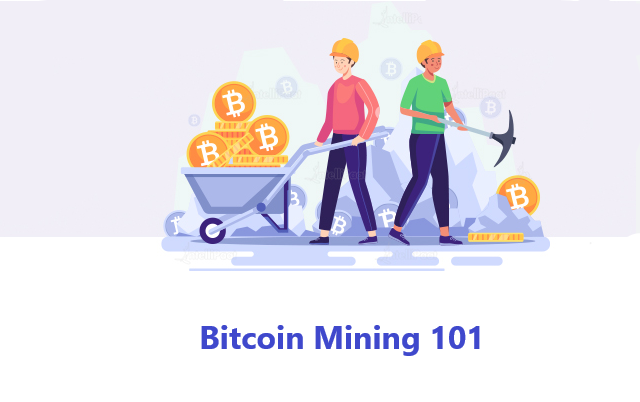Bitcoin (BTC) mining is an exciting way to earn cryptocurrency; anyone can become successful at it; however, it is vital to understand the process before you sink your hard-earned funds into it.
This guide will show you everything you need to know about the Bitcoin mining process, from understanding the basics to setting up your equipment like a pro.
You’ll learn how to set up your hardware, track your progress, and optimize your settings for maximum gains.
What Is Bitcoin Mining, and How Does It Work?
Bitcoin mining involves creating new bitcoins using specialized computers to solve complex mathematical problems. These challenges are deliberately tricky and resource-intensive to create a restricted quantity of bitcoins every 10 minutes.
Miners, decentralized third parties that solve these difficulties, are rewarded with newly produced bitcoins and transaction fees from network users who send and receive bitcoins.
Additionally, BTC mining secures the Bitcoin network by verifying and recording the transactions that occur on the public ledger, called the blockchain.
The blockchain is a chain of blocks, each containing a set of transactions that the miners have validated. It ensures that no one can double-spend or counterfeit bitcoins, as miners check every transaction against the previous blocks.
Bitcoin miners search through billions of hashes each second until they find one that fulfils a criterion known as “difficulty.” And since both the difficulty and the hash are fairly substantial amounts given in bits, the requirement asks that the hash be lower than the difficulty.
Every 2,016 Bitcoin blocks, or roughly every two weeks, the difficulty is readjusted to maintain a constant block time, which refers to how long it takes to locate each new block when mining.
The information from the block header makes up the hash miners produce, which is used to identify any given block.
Changing even the smallest part of a block will noticeably impact its anticipated hash and the predicted hash of every subsequent block. Nodes on the network would immediately reject this false version of the blockchain, thus preventing any malicious interference.
The mechanism ensures that Bitcoin miners put in real effort by requiring a certain level of difficulty to hash through all conceivable combinations.
Because of the process, the consensus protocol Bitcoin uses is known as “proof-of-work” (PoW), setting it apart from other block-creation techniques. The only way hostile actors can attack the network is by completely recreating its mining power, which would cost billions of dollars.
Why Mine Bitcoin?
Bitcoin mining is similar to physical mining in many ways. However, in the case of BTC, mining is a computer process that generates new coins and keeps track of ownership and transactions. Bitcoin and physical mining require a lot of energy but can have substantial financial benefits.
As a result, many miners have resorted to joining mining pools to combine their computing power and divide rewards based on their participation.
Choosing and Setting Up Your Bitcoin Mining Hardware
Now that you understand why Bitcoin mining exists and how it works, the next step is to learn how to set up your hardware. It entails purchasing and assembling specialized equipment, an Application-Specific Integrated Circuit (ASIC), and deciding on a mining pool to join.
ASICs can only mine BTC, but they are so efficient that their introduction around 2013 rendered all previous computational mining machines obsolete.
You can still use your PC’s central processing unit (CPU), graphic processing unit (GPU), or a marginally more powerful Field Programmable Gate Array (FPGA) to mine BTC. Although such gadgets are perfectly capable of mining crypto, they do it so slowly that it only wastes time and electricity.
The number of hashes created in one second is known as the “hash rate,” a key performance metric for mining machines.
When choosing Bitcoin mining hardware, two more criteria should be examined. The first is the electricity use, which is measured in watts. The device that uses the least electricity will be more profitable than two devices that create the same number of hashes.
The final metric is the price per unit of each device. It is pointless to have the world’s most energy-efficient ASIC if it takes ten years to pay for itself through mining.
BTC has a thriving ecosystem of ASIC makers who frequently diverge on the abovementioned criteria. Some may manufacture better-performing but more expensive ASICs, whereas others may produce less productive but cheaper hardware.
Therefore, finding a balance that works best for you before determining which equipment best suits your needs is critical.
Once you have all the necessary components, you must download and run the appropriate software. It’s important to note that additional steps may be involved in installation depending on your setup, so follow the instructions with your software closely.
Bitcoin Mining Pools vs. Solo Mining
Mining for Bitcoin can be done either solo or in mining pools. When mining solo, it requires your hardware and software and the technical know-how to set up and maintain the necessary components, like the Bitcoin wallet.
However, the profits may be greater if you join a mining pool, which entails collaborating with other miners to boost your chances of earning bitcoins. Mining pools distribute rewards in proportion to each individual’s contribution.
Here are some things to think about while choosing a mining pool:
- Size of the pool: the larger the pool, the more likely you will get rewards. However, larger pools also mean more competition in returns.
- Fees: Some pools require fees (e.g., maintenance fees) that can reduce your overall earnings.
- Mining Difficulty: Pool difficulty settings should be tailored to your hashing power so that you can get the best results from your equipment.
- Reputation: Look into reviews of the pool before committing; this will help ensure that you’ll receive regular payouts and adequate customer service.
Joining a Bitcoin Mining Pool
For those just starting with mining Bitcoin, it can be helpful to join a mining pool where miners can collaborate and contribute their computing power towards the same goal. In a mining pool, all participants combine their computational power and share the rewards they earn.
Pooled mining makes sense when you’re new to the Bitcoin mining game because it decreases your chances of earning rewards without investing too much in expensive hardware. It also helps ensure consistent returns for all members, regardless of their computing power.
Before joining a pool, consider these factors:
- Pool fees: Most pools charge a fee for participating. Be sure to read through the fee structure before signing up for a pool so that you can understand the cost structure involved.
- Minimum payouts: Some pools will have a minimum earning threshold before you can withdraw your earnings. Make sure that you choose a comfortable pool for your earning expectations.
- Mining protocols: Each Bitcoin mining pool typically uses one of two protocols — Stratum or P2Pool — to assign work and share block rewards fairly among members. Understand which protocol your chosen pool uses before joining it so that you are better able to understand how payments will be distributed among members.
How to Get Started With Bitcoin Cloud Mining
Do you want to mine Bitcoin but want to avoid investing in expensive hardware? Bitcoin cloud mining is an excellent way to start without purchasing and setting up your mining rig. Here’s all you need to know to get started with cloud mining:
What is Cloud Mining?
Cloud mining means acquiring hashing power from a third-party source instead of acquiring and operating your own BTC mining hardware. This hash power is then shared with other users who possess hardware in the provider’s data centre.
Users can save money by not investing in their powerful gear and using pooled hashing power.
What Equipment Do I Need?
The beauty of cloud mining is that you don’t need to buy any gear. Once you’ve signed up for a cloud mining service, you can access the necessary BTC mining software and hardware. You will need a wallet address for receiving payments and an internet connection for operating the associated software.
How Does Cloud Mining Work?
Cloud mining involves sharing overhead costs among multiple miners, significantly reducing the amount of electricity consumed by each user. Once your account is set up, you can start earning Bitcoin in three steps: select a package with the right hash rate, provide your wallet address so that payouts can be transferred when reached, and begin hashing away!
Earning and Selling Your Mined Bitcoin
After mining Bitcoin, you can sell your stash for fiat money or use it to make purchases of goods and services. Of course, you can also stockpile the cryptocurrency and keep hoarding it, hoping its value will rise over time.
It’s also important to remember that earning bitcoins through mining isn’t guaranteed and often involves considerable risks.
Besides hardware selection, market conditions and other miners’ existence significantly impact each miner’s profitability and income. During bull markets, the price of Bitcoin may rise, increasing the monetary value of the BTC produced.
On the other hand, positive inflows from bull markets are offset by other Bitcoin miners recognizing increasing earnings and acquiring more devices to get into the revenue stream. As a result of this, each miner now produces less BTC than before.
Eventually, the money earned approaches a point of equilibrium where less efficient rigs bring in less than they use on electricity, causing them to be turned off while others earn more BTC.
Of course, it usually takes time to happen. There is some lag because ASICs are only sometimes produced quickly enough to compensate for the increase in BTC price.
In a bear market, the opposite applies: earnings are reduced until miners begin to turn off their equipment in large numbers. Existing Bitcoin miners must find an effective mix of location and gear to keep their competitive advantage and avoid being outfoxed by their peers.
When figuring out your device’s profitability, various calculators, such as AsicMinerValue, CryptoCompare, and Nicehash, can quickly help you.
The required input quantities are set parameters or can be discovered on data websites such as Blockchain.com or Coinmetrics.
To calculate the profit, remove the cost of electricity, which can be as simple as multiplying the device’s power usage by 24 hours and the energy price per kilowatt hour.
However, it’s important to note that a miner’s earnings often swing significantly over time, and extrapolating a single day into the future can result in erroneous statistics. Nonetheless, it’s a valuable indicator for determining each device’s relative effectiveness.
Conclusion
Bitcoin mining is a highly technical process requiring specialized knowledge and resources. However, with patience and dedication, anyone can become a miner and earn Bitcoin.
By following this guide, you can learn how to select the proper hardware, set up your mining rig, join a mining pool, and begin the process of mining.
To build the optimal mining rig, you must follow the best practices for selecting a mining app, hardware, and crypto wallet. Conversely, beginners should consider employing cloud mining services or pools to minimize entrance hurdles.
The good thing is that mining software sophistication and continuous developments in hardware technologies can give crypto-mining newcomers fresh opportunities.
You can efficiently build up a mining infrastructure once you have defined your resource availability and financial goals. Begin learning about Bitcoin mining and selecting the best hardware and software.

